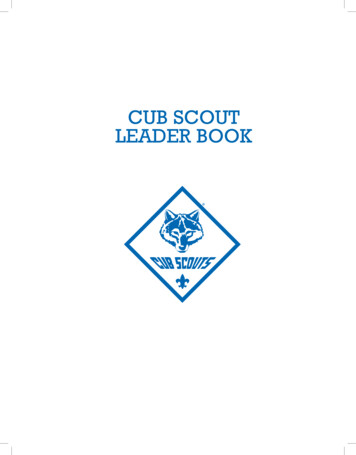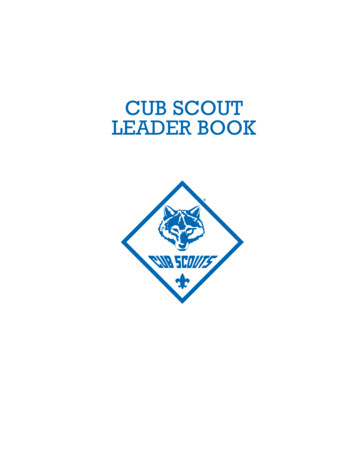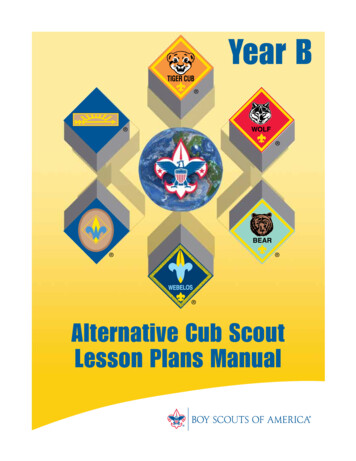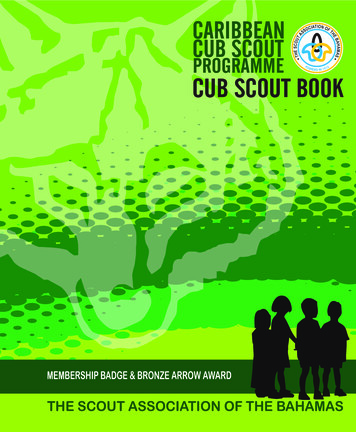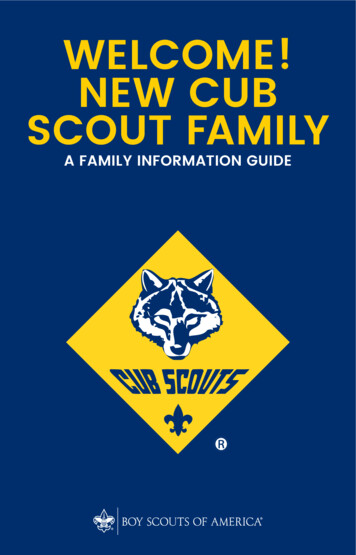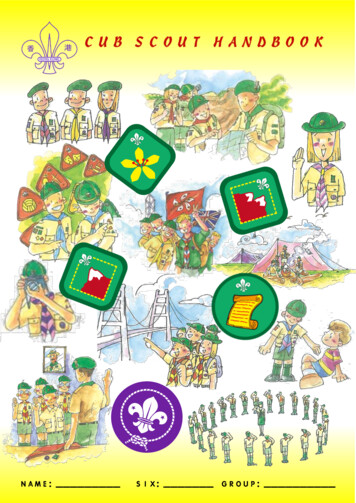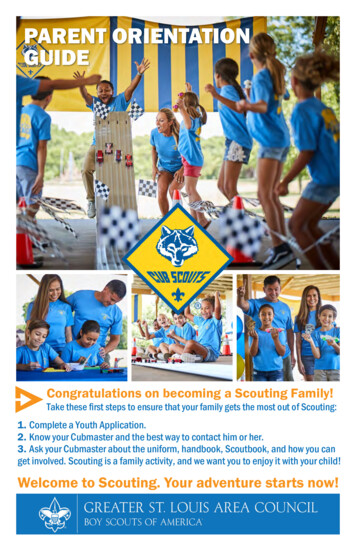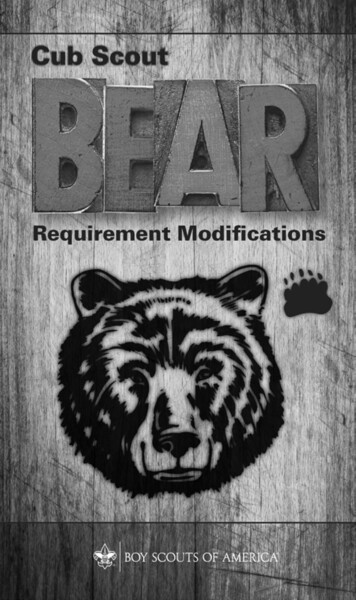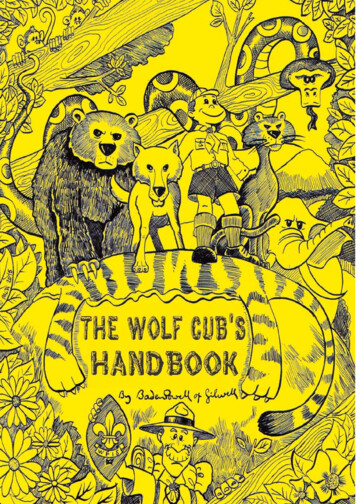
Transcription
THE WOLF CUB’SHANDBOOKBYLORD BADEN‐POWELL OF GILWELLAuthor of "Scouting For Boys," Etc.9th Hard copy Edition — 1938WFIS electronic Edition — 2015
FOREWORDThis WFIS edition of Wolf Cub Handbook – Boys’ Edition, is basedon an original 1938 copy written by Lord Baden‐Powell of Gilwellhimself. It remains mostly in its original form with some minorchanges to reflect today’s society and language. The book is writtenas a story from B.‐P. to the Wolf Cub, telling him about what a won‐derful life cubbing can give and what he must do to become a WolfCub.He wrote the book directing it to boys, but it can be equally be usedby girls by ignoring the gender of the content. The editors have pur‐posely not changed the gender as that was not the Founder’s intent,although scouting throughout the world contains both genderstoday, as it was when it first started before the inclusion of GirlGuides.There have been many editions of The Wolf Cub Handbook since theones written by B.‐P. himself, each editor making changes along theway. The World Federation of Independent Scouts, in keeping withtraditional values, have strived to keep the original, hoping the readerwill understand more about our Founder and the reasons he felt itwas important to begin the Scouting Movement.As you read through these pages, try to think as he did when hewrote these words and remember that this is his story to you, theWolf Cub. He did not write this book for adults and non‐scouts, al‐though many have read his works. Adults will also read this book tohelp you become a better Wolf Cub, but they must also rememberwhy the book was written and who it was written for.It is the desire of the WFIS that every Wolf Cub will read this andkeep a copy to help them through their scouting life.Good hunting to you!World Federation of Independent Scouts2015 ‐ All rights reservedpage 4The Wolf Cub’s Handbook
INTRODUCTIONEvery boy, like every young Wolf, has a hearty appetite. This book isa meal offered by an old Wolf to the young Cubs.There is juicy meat in it to be eaten, and there are tough bones to begnawed.But if every Cub who devours it will tackle the bone as well as themeat, and will eat up the fat with the lean, I hope that he will getgood strength, as well as some enjoyment, out of every bite.B.‐P.To Rudyard Kipling, who has done so much to put the right spiritinto our rising manhood, I am very grateful for the permission toquote as my text his inimitable "Jungle Book."My thanks are also due to his publishers, Messrs. Macmillan and Co.,Ltd., for their courtesy in allowing these extracts to be made.PREFACE TO THE NINTH EDITIONAnother seven years have passed and it is time for yet another editionof the Handbook.Broadly speaking, the main scheme of Cubbing has the test of timeand there are few alterations in the present edition, except those ne‐cessitated by the current revision of Star and Badge Tests, whichcome into force in October, 1938.August, 1938. B.‐P.The Wolf Cub’s Handbookpage 5
THE LAW OF THE WOLF CUB PACK1. The Cub gives in to the Old Wolf;2. The Cub does not give in to himself.THE WOLF CUB’S PROMISEI promise to DO MY BEST —To do my duty to God and the King,To keep the Law of the Wolf Cub Pack,and to do a good turn to somebody every day.page 6The Wolf Cub’s Handbook
This electronic edition 2006 Canadian Sea Scouts Homeport 2015 World Federation of Independent ScoutsAll rights reservedCover illustration by Mario PaltaThe Editors gratefully acknowledge with thanks the invaluable as‐sistance of Karl Pollak and Ric Raynor in preparing this edition.It is the volunteers like they who are the strength of the Movement.Editor’s Notes:The reader is reminded that these texts have been written a long timeago. Consequently, they may use some terms or express sentimentswhich were current at the time, regardless of what we may think ofthem at the beginning of the 21st century. For reasons of historicalaccuracy they have been preserved in their original form.If you find them offensive, we ask you to please delete this file fromyour system.This book was written in England and thus contains English spellingand English terms.A publication of WFIS LibraryThe Wolf Cub’s Handbookpage 7
ContentsPART IFIRST BITE.11Story Of Mowgli — Wolf Cubs — Zulu Boy — Duties Of Cubs — CirclesOf The Council Rock — The Grand Howl Game: Shere Khan And Mowgli. .21SECOND BITE.22Akela. Baloo and Bagheera — The New Chum — The Salute — TabaquiDance — Pronunciation Of Jungle NamesTHIRD BITE.28The Law of The Wolf Cub Pack — The Dances of Baloo And Bagheera —Mothering DayFOURTH BITE.39The Bandarlog — The Cub Promise — The Hunger Dance Of KaaFIFTH BITE .49The Goodfellows — How To Make Yourself Useful At Home — Zulu BoyGame — The Dance Of Shere Khan’s DeathSIXTH BITE.57The Uniform — The Investiture Of A Tenderpad — The Six Totem PolesSEVENTH BITE.62The Stars — First Star Tests — The Union Jack And How To Fly It — FlagGameEIGHTH BITE.67Observation — Training Senses — Stalking — A Snow Newspaper —Track Reading — PetsNINTH BITE.83Niagara Ice Accident — Knots — Swimming — Seamen — Jack Cornwell,V.C. — The Wolf Cub’s LairTENTH BITE.92How To Grow Big And Strong — The Blood — Wholesome Food — DailyCleansing — Fresh Air — Exercise — Skipping, Walking, Leap‐Frog AndHead‐Over‐Heels — Nose Breathing — Nails And Their Care — TeethAnd Their Care — Feet — Telling The Time — "God Save The KiELEVENTH BITE.109page 8The Wolf Cub’s Handbook
The Second Star — SignallingTWELFTH BITE .119Fire‐Lighting (Indoors) — Bush Fires — More Knots Running Messages —Points Of Compass — TelephoneTHIRTEENTH BITE .126Knitting And Weaving — Thrift — Models — Collections — Scrap‐Books— Cubs’ Band.FOURTEENTH BITE .134Camping — Comfort In Camp — Bed‐Making — Camp Kit — Camp Pro‐gramme — Things To RememberFIFTEENTH BITE .142Dirt In A Wound — Burns — Scalds — Shock — Bodyexercises — Walk‐ing The Plank — Investiture Oftwo‐Star CubSIXTEENTH BITE .149PART IICHAPTER I.153Proficiency BadgesCHAPTER II .163CollectorCHAPTER III .167ObserverCHAPTER IV .175GardenerCHAPTER V .179ArtistCHAPTER VI.185HomecraftCHAPTER VII .190ToymakerCHAPTER VIII .193First AiderCHAPTER IX .198The Wolf Cub’s Handbookpage 9
GuideCHAPTER X .203House OrderlyCHAPTER XI .207AthleteCHAPTER XII.210SwimmerCHAPTER XIII .215Team PlayerPART IIIObjects And Methods Of Wolf Cub Training .222page 10The Wolf Cub’s Handbook
PART IFIRST BITEStory Of Mowgli — Wolf Cubs — Zulu Boy — Duties Of Cubs — CirclesOf The Council Rock — The Grand Howl Game: Shere Khan And MowgliNOTE TO THE CUBMASTER"The Jungle Books," by Rudyard Kipling, are the basis of the Wolf storywhich is our theme in the first fear "bites." If you can read the books to theCubs after giving the outline as above they will enjoy and appreciate itsmeaning all the more.Once upon a time, far away in India, a great big tiger was prowlingabout in the jungle trying to find food. Presently he came to a placewhere a wood‐cutter and his family were camped, and he thought itwould be a grand thing to get hold of a sleeping man or, better still,a fat child for his supper.Although he was a great strong animal he was not very brave, andhe did not want to face an armed man in the open.So he crept up close to the camp fire, but in gazing at his prey he didnot look carefully where he was putting his feet, and in crawling for‐ward he trod on some hot embers.The pain made him howl, which roused the camp, and he had to golimping away hungry.One small boy ran off into the bushes to hide, and there he met a greatgrey Wolf. But the Wolf was a brave and kindly animal, and seeingthat the child was not afraid of him he picked him up gently in hismouth as a dog does a puppy, and carried him into its cave close by.Here the Mother Wolf took care of the child and put it among herfamily of cubs.Shortly afterwards Tabaqui, that is the jackal, came to the tiger whosename was Shere Khan and said to him, "Mr. Tiger, I know where thatsmall boy has gone to, and if you will kill him you might give me aThe Wolf Cub’s Handbookpage 11
nice little bit of him to eat as a reward for my telling you where tofind him. He is in that little cave under the rock."A jackal is a nasty sneaking kind of animal, who lets other animalsdo the hunting and killing, while he loafs about picking up the scraps.So Shere Khan went to the mouth of the cave, and though he couldput his head inside, the opening was too small for his body to getthrough, and the grey Wolf inside knew this and defied him.The Wolf told him to go away and hunt for his food, and not to gotrying to steal what other folk had captured; he must not break theLaw of the Jungle which says that no animal shall kill a human beingbecause it causes more men to come to the place to hunt out the mur‐derer, and this brings trouble on all the animals in that jungle.Shere Khan roared with anger, and wanted to bully the Wolf withthreats of what he would do to him, when Mother Wolf suddenlyjoined in and told him to go about his business; that she would takecare of the boy, and that some day the boy would grow up and killShere Khan if he was not careful.So the boy remained with the Wolves and grew up as one of the fam‐ily. They called him Mowgli —and they taught him all thetricks of the Jungle; how to runand how to hunt his game.In this way he became braveand strong. Then they also tookhim to the Council meeting ofthe Pack of all the Wolveswhich was held at a certainrock.As a young wolf he had lots tolearn.The Wolf Cub looks up to the Boy Scoutand the Boy Scout looks up to the OldScout or Pioneer.page 12In Northern Trails, by W. J.Long, you can read how a wolfcub learns his hunting lessonsfrom his parents.The Wolf Cub’s Handbook
The first lessons are to make him quick and active, and for this he isallowed to hunt grasshoppers — to leap and snap, and twist andpounce after them. Then he is not given any food, but is shown thatif he wants it he must go and hunt it for himself.He tries his pouncing and rushing dodges on birds, but very soonfinds that these do not pay. If he wants to kill, he must creep andcrawl and stalk, and lie in wait. If he does not learn to do the businessproperly, he will starve to death. His dinner depends on himself.It is just the same with a boy who wants to be a Scout. He must firstof all learn all the scouting dodges and duties from old Scouts, whocan teach him.He, too, must makehimself active andstrong by games andexercises; he, too, mustmake his own way inlife, but games will notdo this for him. If hewants to succeed hemust go about it care‐fully, learning all hecan that will help himin whatever professionhe takes up. His suc‐cess will depend onhimself, not on hismasters or parents.From left to right you see an Um‐fan (mat‐boy), aSo make up your mindyoung warrior, and a Ring‐Kop veteran. These cor‐respond to our Wolf Cubs, Boy Scouts and Scouters. to be like the real WolfCub, and win yourown success for yourself. Later on when you are a Scout you willlearn how to do it when you are grown up.THE WOLF CUBSYoung Scouts who are not quite old enough to join the Boy Scoutsare called "Wolf Cubs." Why? For this reason, a Wolf Cub is a youngThe Wolf Cub’s Handbookpage 13
Wolf. Scouts are called "Wolves," and young Scouts are thereforecalled "Wolf Cubs."In the far Western prairies of America the Red Indians were a nationof scouts. Every man in the tribe was a pretty good scout. Nobodythought anything of him if he wasn’t.So there was great rivalry among the young braves as to who couldbe the best scout. And those who proved themselves best got the nick‐name of "Wolf."There would be "Grey Wolf," or "Black Wolf," "Red Wolf," "LeanWolf," and so on; but "Wolf" was the title of honour, meaning a realgood scout.If you went across the world to South Africa, though the people wereentirely different (they were negro savages instead of Red Indians),you would find that they, too, were good scouts, and they, too, calledtheir best scouts "Wolf."A scout, as you know, is a man who is brave and strong, who will‐ingly risks death in order to carry out his duty, who knows how tofind his way over strange country by day or night, who can look afterhimself, light his fire, cook his own food; he can follow the tracks ofanimals or men, can see without being seen; at the same time he ishelpful and kind to women and children, and, above all, he obeys theorders of his chief to the death.In South Africa the finest of the tribes were the Zulus, with their off‐shoots the Matabele, the Swazis, and the Masai.These were, every man of them, good warriors and scouts, becausethey learnt scouting while they were yet boys.The boys of the tribe always went on the warpath when the menwent, in order to carry the sleeping‐mats and food for the warriors.They did not fight themselves; they only looked on at a distance atthe battles, and learnt how to behave when it should come to theirturn. The smartest and best of the boys were the "Wolf Cubs," the fu‐ture Wolf Scouts of the tribe.page 14The Wolf Cub’s Handbook
THE TEST OF THE ZULU BOYBut before they were allowed to become scouts and warriors they hadto pass a pretty tough examination. This is what they had to do.When a boy was becoming old enough to be a warrior he was takenand stripped of his clothing, and was painted white all over. He wasgiven a shield with which to protect himself, and an assegai or smallspear with which to kill animals or enemies. And he was then turnedloose into the "bush."If anyone saw him while he was still white they would hunt him andkill him; and that white paint took about a month to wear off — itwould not wash off.So for a month the boy had to hide away in the jungle, and live asbest he could.He had to follow up the tracks of deer, and to creep up near enoughto spear the animal in order to get food and clothing for himself. Hehad to make fire to cook his food by rubbing two sticks together —he had no matches with him. Nor had he any pockets to put them inif he had them. He had to be careful not to let his fire smoke toomuch, or it would catch the eye of scouts on the look‐out to hunt him.He had to be able to run long distances, to climb trees, and to swimrivers in order to escape from his pursuers. He had to be brave, andstand up to a lion or any other wild animal that attacked him.He had to know which plants were good to eat and which were poi‐sonous, and how to cook them. He had, of course, to make his owncooking pots out of the bark of trees or of clay. He had to build him‐self a hut to live, but well hidden.He had to take care that wherever he went he left no foot tracks bywhich he could be followed up. If he snored when he was asleep, itwould give him away to a keen‐eared enemy. So he learnt to keephis mouth shut, and to breathe quietly through his nose.For a month he had to live this life, sometimes in burning heat, some‐times in cold and rain.When at last the white stain had worn off, he was able to return tohis village, and then he was received with great joy, and was allowedto take his place among the young warriors of the tribe.The Wolf Cub’s Handbookpage 15
He could go on, and by his bravery get to be a "Ring‐Kop" — that is,a real proved warrior, who was allowed to wear a ring on his head.Then he could possibly go on, and in the end earn the honourabletitle of "Wolf."But you can imagine that a good many boys who went out did notget through their white period at all; some got killed by wild animals,some got killed by the men, and numbers of them died of starvationor of cold, or got drowned. It was only the good ones among themwho got through successfully — and thereby proved that they reallywere good men.It was a pretty stiff exam, wasn’t it?BRITISH SCOUTSIn our own country hundreds of years ago our scouts were theKnights — men who were ready to die for their duty, and who weresworn to be polite to old people, and generous and kind to womenand children.They, like the Zulus, first learnt their duties while boys — that is, aspages who attended on the Knights, and helped them to put on theirarmour. As these grew up into young men they became Esquires andlearnt to ride and to use their weapons, and to carry out the laws ofthe Knights, so that they would be true Knights when they hadproved themselves really good at their duty and worthy of promo‐tion, just like the young warriors of the Zulus.That was all hundreds of years ago, and lots of boys have said theyonly wish that the Knights lived now and carried on their duty as ofold, and they themselves would be glad to become their pages andEsquires. Well, so they do exist today in a way.The men whom I look on as our Knights and scouts of today are thefrontiersmen in the wilder parts of our Empire. The backwoodsmen,the hunters, the explorers, the map‐makers, our soldiers and sailors,the Arctic navigators, the missionaries — all those men of our racewho are living out in the wild, facing difficulties and dangers becauseit is their duty, enduring hardships, looking after themselves, keepingup the name of Britons for bravery, kindness, and justice all over thepage 16The Wolf Cub’s Handbook
world — those are the scouts of the nation today — they are the"Wolves."But they could not do it if they had not learnt their work thoroughlywhile they were still boys.HOW BOYS CAN LEARN TO BECOME SCOUTSSo the boys of the British Empire have the chance of learning how tobecome its scouts by being Boy Scouts first, just as in the old days theEsquires learnt how to become Knights.Then, too, the young Scouts, the "Wolf Cubs," like the pages of old,preparing to be Esquires, can learn how to become Boy Scouts whenthey get to the right age for it.THE DUTIES OF A WOLF CUBIn the bites that follow I am going to show you how to pick up thedifferent Wolf Cub duties, such as tying knots and lighting fires, howto make yourself comfortable in camp, how to build your lair, howto find your way in a strange country, how to signal to your pals,how to do good turns to people and how to help in the case of acci‐dents.It doesn’t matter whether you are a rich boy or a poor boy, whetherin the country or in a town. You can learn these things quite easily ifyou go about it in the way I tell you.THE COUNCIL ROCK AND CIRCLESWhen the wolf pack met in the jungle, Akela, the oldwolf, stood on a great rock in the middle, and the packsat in a circle all round it.So with our Wolf Cub Pack, we may mark out the rock by a small cir‐cle of stones, or pegs, or with chalk, like this:The Rock Circle is about three paces across, with flagstaff or TotemPole in the centre.The Wolf Cub’s Handbookpage 17
TO FORM PARADE CIRCLEWhen the Pack is formed up in Rock Circle, the Cubmaster gives thecommand "Form Parade Circle," and each Cub holds hands with theCub on either side and pulls outwards into a big circle.Council rockRock circleParade circleThis circle is used, for the Grand Howl, for Jungle Dances and for ral‐lies.THE JUNGLE MEETINGWhatever you may be doing, the moment that you hear the call of"Pack — Pack — Pack" every Cub at once answers by yelling "Pack!"and by scampering at once to form the Parade Circle round the Cub‐master. If the Cubmaster only calls "Pack!" once it means "Silence!"and every one must stop what they are doing and listen.No one is allowed to call "Pack!" except an Old Wolf. The Sixer maycall his Six together by its Six colour.THE ALERTRemember when ordered to be "Alert," the Cub stands straight uplike a soldier, with heels together, hands down by his sides, chestwell advanced, head up, and eyes looking straight to the front —nowhere else.When the command is given "At ease," you stand with feet apart, andhands clasped behind your back, and you may then look about youas much as you please.page 18The Wolf Cub’s Handbook
THE GRAND HOWLThe wolves all sat round the council rock in a circle and when Akela,the old wolf, the head of the pack, took his place on the rock they allthrew up their heads and howled their welcome to him.When your Old Wolf, Akela — that is your Cubmaster or otherScouter — comes to your meeting you salute him by squatting roundin a circle as young wolves do, and giving him the Wolf Cub GrandHowl.So form yourselves into a circle(quickly, a Wolf Cub neverwalks, he runs!).Then squat down on your heelswith your two fore paws on theground between your feet, kneesout to either side like this:The Wolf Cub’s Handbookpage 19
Then when the Old Wolf comes to the Pack, the young Wolves throwup their heads and howl. But their howl means something. They wantto welcome him, and at the same time to show that they are ready toobey his command.The call of the Pack all over the world is "We’ll do our best"; so whenyour Cubmaster comes into the circle you chuck up your chins and,all together, you howl out — making each word a long yowl: "Ah‐kay‐la! — We‐e‐e‐e‐ll do‐o‐o‐o o‐o‐o‐u‐u‐r BEST." Yell the word "best"sharp and loud and short and all together; and at the same timespring to your feet with two fingers of each hand pointing upwardsat each side of your head, to look like two wolf’s ears.That’s the way to do it. Now what does it mean?It means that you will do your best with BOTHhands — not merely with one like most boys, whoonly use their right hand. Your best will be twiceas good as any ordinary boy’s best. "Do your best"is the Cub’s motto.Then keep your two hands up while the leadingCub calls to the Pack, at the top of his voice: "Dyb‐dyb‐dyb‐dyb" (meaning Do Your Best).Then every Cub after the fourth "dyb" drops hisleft hand smartly to his side and keeping the righthand at the salute, with two fingers up, but nowspread out making the salute, squeals "We‐e‐e‐l"and barks out "Dob‐dob‐dob‐dob" (We’ll Do Our Best).After the fourth "dob" each Cub drops his right hand smartly to hisside and stands at the "Alert" and waits for orders.Now squat down again and see how well you can do the Grand Howlto the Old Wolf.GAME: SHERE KHAN AND MOWGLIFather Wolf, Mother Wolf, and all the little wolves form a string onebehind the other with Mowgli, the smallest, as last in the string. Eachcatches hold of the waist of the one in front of him.Then comes along Mr. Shere Khan, the tiger. He wants to catchpage 20The Wolf Cub’s Handbook
Mowgli — but whenever he tries to get him Father Wolf puts himselfin the way to stop him, and all the string of wolves clinging to eachother try to keep Mowgli safe behind them. Mowgli has a neckerchiefhanging like a tail behind him from under his jersey, and if ShereKhan can get his tail within three minutes he wins the game, other‐wise the wolves win.The Wolf Cub’s Handbookpage 21
SECOND BITEAkela. Baloo and Bagheera — The New Chum — The Salute — TabaquiDance — Pronunciation Of Jungle NamesCommence with the Grand Howl.Now I want to tell you some more about Mowgli and the Jungle Pack.Do you remember who the chief animals were?Akela was the wise Old Wolf, the head of the Pack, who lay on theCouncil Rock and saw the younger Wolves all kept the Law of thePack. He was like an older man who could teach boys what to do tomake themselves strong and useful.Akela is an Indian word, and it means "one who is alone." There canbe only one Cubmaster leading the Pack, just as Akela was alone onthe Council Rock. If there were several leaders in a Pack, they mightall try to do different things at the same time, and some Cubs wouldfollow one, and some another, until in the end your Pack would belike the Seeonee Pack of the Jungle Book, after the wolves set theirold Akela aside and followed many leaders. After awhile, some ofthem were lame from the traps they had fallen into, some limpedfrom shot wounds and some were mangy from eating bad food, andmany were missing. If they had followed Akela, the one leader of thePack, that would never have happened.Shere Khan was the great bullying tiger, all stripes and teeth andclaws; but, like most bullies among boys, was not very brave at heartif you only tackled him.Then Tabaqui was the mean sneaking jackal who tried to makefriends with everybody by flattering them; but he only wanted to getscraps from them. There are lots of boys like Tabaqui who will sneakor suck up to others hoping to get things given to them instead ofworking for them themselves.So you see the animals in the jungle are very like human beings intheir ways.But there are more animals in the jungle than those I have told youabout.page 22The Wolf Cub’s Handbook
When Mowgli was brought to the Council Rock he had to be madeone of the Pack, which meant that he would have to be taught thelaws and customs of the Pack before he could properly be made amember of it. So old Baloo the bear, who was a wise though fat andsleepy old beggar, was told off to teach him the laws. And Bagheerathe great black panther, who was a strong and cunning hunter, wasto teach him his hunting and jungle work.So in your Pack I expect you will learn to call your Cubmaster"Akela," because he is your leader. If he has other grown‐ups to helphim, perhaps you will call them "Baloo" and "Bagheera." When youspeak about all of them together, you can call them "Old Wolves."Why not give some of the Cubs in your Pack special Jungle names?The Sixer of the Grey Six might be called "Grey Brother," for example;or the cheeriest Cub might be "Rikkitikki‐tavi" (or "Rikki," for short);or the Pack Scribe might be "Sahi" (the Porcupine).THE NEW CHUMA boy who wants to be a Wolf Cub is called a "New Chum" or "Re‐cruit" until he has learnt the Laws of the Pack, the Promise, the Salute,and the Grand Howl and their meaning. Then he is admitted to be aTenderpad, and to wear the uniform of the Wolf Cubs.He is called a Tenderpad because when he goes out to catch his preyor to play in the Jungle, from not knowing how to do it he runs wildlyand loses his way and soon gets tired and his poor feet or "pads" getsore and tender.But as soon as he knows a few of the dodges he becomes a full blownCub.THE SALUTENow for the secret sign by which Cubs salute their Cubmasters andother Cubs, and Scouts, too.You have learnt "the Grand Salute" which you use when doing theGrand Howl to an Old Wolf, but if you meet him or speak to him atany time you use the ordinary salute.The Wolf Cub’s Handbookpage 23
You do it in this way, with the right hand only, forefinger touchingthe cap.Why two fingers up?Well, you know what a Wolf’s head looks like with his two earscocked up. It is used as the badge of the Wolf Cub. Your two fingersin the salute are the two ears of the Wolf.When you meet another Cub or a Scout, or anyone wearing the but‐tonhole badge of a Scout or Cub, give him or her the salute.THE TABAQUI DANCETabaqui is the jackal, a sneaking sort of a fellow. He is afraid to goabout alone, so he always keeps near his fellow jackals; although hetries to look like a Wolf he never hunts or earns his food like one, butpage 24The Wolf Cub’s Handbook
sneaks about trying to steal or beg it from others. Then when he hasgot it he is not a bit grateful, but runs about yapping and yelling, dis‐turbing the game and making a regular nuisance of himself. Thereare lots of boys like Tabaqui who rush about yelling and making littleasses of themselves and bothering people, always ready to beg for apenny or a bit of grub, but never anxious to do any work. They arequite ready to jeer or throw mud at people if they are at a safe dis‐tance away, but are awful little cowar
Wolf Cub. He did not write this book for adults and non‐scouts, al‐ though many have read his works. Adults will also read this book to help you become a better Wolf Cub, but they must also remember why the book was written and who it was written for. It is the desire of the WFI
